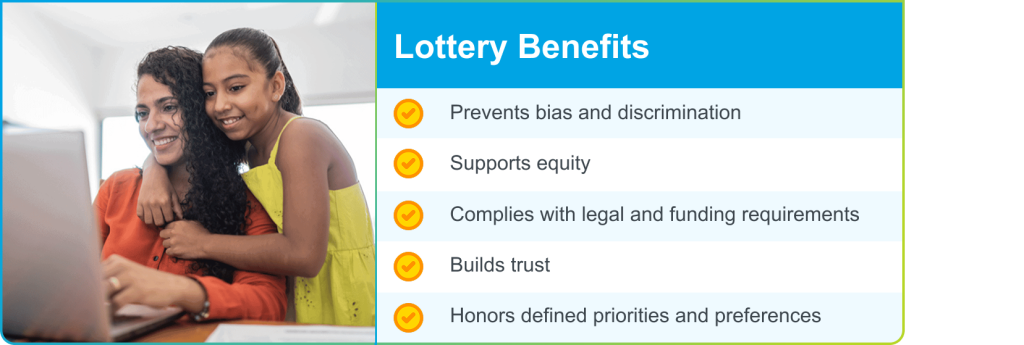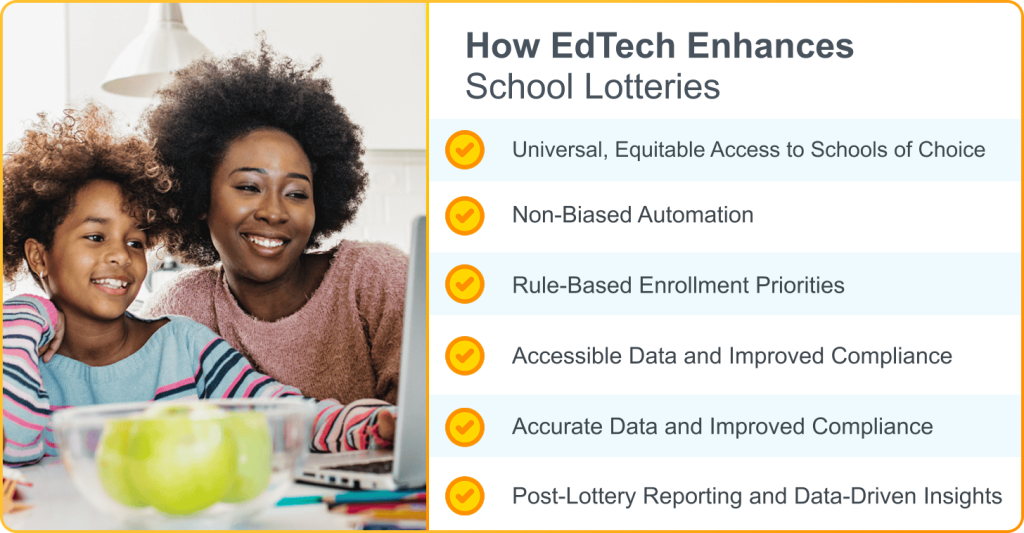How EdTech Supports Equitable Access to Education for Families
What is School Choice?
School choice refers to policies that expand educational options for families beyond their traditional neighborhood public school assignment. Choice programs empower parents to select schools based on educational philosophy, curriculum, school ratings, or even proximity to a family member’s workplace. Equitable school choice should level the playing field—addressing barriers like income, location, access to information, and admissions policies that may limit opportunity.
At times, school choice has sparked intense debate in education policy. Proponents praise the policy for providing families with more educational choices and fostering competition among schools. Critics, however, raise concerns about equity, funding, and potential segregation.
Despite the debate, the demand for school choice programs is surging, leading to a nationwide wave of increased legislative support. More states are adopting school choice policies, reflecting the growing interest and support from families and legislative bodies across the country.

Types of School Choice Policies
School choice encompasses a variety of programs designed to expand educational options for families.
While many people associate school choice with funding for private schools, the policies more commonly support public school options. Programs might include:
- Charter Schools: These independently run public schools offer free enrollment and operate with more flexibility than traditional public schools.
- Magnet Schools: These public schools offer free enrollment and specialize in a particular focus or interest, such as STEM or the arts.
- Inter/Intra-District Choice: Some districts allow families to choose traditional public schools outside of their assigned zone (inter-district) or within their zone but at a different school (intra-district).
Private school options are often financially out of reach for many families, and school choice policies aim to offset some of these expenses through a range of options:
- Educational Savings Accounts (ESAs): These government-authorized accounts allow families to save money specifically for educational expenses, including private school tuition.
- Vouchers: In a voucher system, school district funds are allocated to participating families for private school tuition.
- Scholarship Tax Credit Program: These programs provide tax credits to individuals or businesses that donate to organizations offering scholarships to private school students.
- Individual Tuition Tax Credits: Tax credits are given directly to taxpayers who pay out-of-pocket private school tuition, reducing families’ financial burden.
More innovative and less traditional methods of school choice offer even greater flexibility and personalization for families:
- Homeschooling: Each state has its own laws governing homeschooling options, but many include homeschooling options within their school choice legislation.
- Microschools: These small, often specialized schools have highly specialized instruction focused on a specific topic or learning approach.
- Virtual Schools: With the rise of online learning, students have a wide range of virtual schooling options, broadening education without location restrictions.
Read more: What is School Choice? How It Affects District Schools, How Educators Can Help Families Make the Right School Choice
Why Applications and Lotteries Matter in School Choice
Every school has varying application windows and requirements. Some schools have centralized applications for multiple school choice programs, while others require applications directly to individual schools. Schools with specialized programs (STEM or visual and performing arts) may have additional application requirements, such as essays or written statements, auditions, interviews, and entrance exams.
Additionally, many school choice programs have limited seats. If applications exceed capacity, lotteries are often used to determine enrollment fairly.
An enrollment management system provides several benefits:

- Prevents bias and discrimination, giving all applicants an equal chance regardless of background
- Supports equity by reducing bias, especially in communities with historically limited access to quality education
- Complies with legal and funding requirements, especially for schools receiving public funds that mandate random selection methods
- Builds trust with families by showing the school’s commitment to fairness
- Honors defined priorities and preferences to support enrollment goals while maintaining transparency
The growing complexity of school choice options and their application processes can leave families feeling overwhelmed and confused. As educators in a school choice state, it’s important to offer equal access and transparency so families are informed and confident in their ability to navigate school choice options, eligibility requirements, and the application processes.
Read more: How Educators Can Help Families Make the Right School Choice
The Role of Education Technology in Modern School Choice Processes
Technology plays a pivotal role in achieving a transparent, clear, and efficient enrollment process that maximizes students’ opportunities to find the right educational fit. However, how a school randomizes its selection process can vary greatly. Some rely on computerized programs, while others prefer traditional name drawing.
The Challenges of Traditional School Lotteries
While traditional school lotteries were designed to help schools fill available seats with interested students, they weren’t designed to keep up with today’s complex and competitive school choice landscape. Many traditional methods (e.g., pulling names from a hat) started when schools were much smaller and running a manual lottery was manageable.
As the schools have grown and school selection processes have become more involved, the shortcomings of manual processes or aged systems, like spreadsheets, have become more obvious.

Risk of Human Bias
Even with the best intentions, manual processes can introduce errors or unconscious bias. Slight variations in materials or drawing methods can affect outcomes, potentially leading to costly disputes, especially in schools required to follow fair selection laws.
Errors and Inefficiency
Manually handling hundreds of applications is time-consuming and prone to serious mistakes. Regulatory updates may require reworking entire systems, and inconsistent data entry, especially if more than one person manages submissions at different times, can result in lost applications, missed deadlines, and process breakdowns.
Lack of Transparency
Families want clarity, but without an enrollment system, real-time updates, or a clear explanation of the selection process, they may lack information and question whether the process was truly random or if their child had a fair shot. For multilingual communities, a lack of language support can limit access and leave families feeling isolated.
Difficulty in Tracking Lottery Results
Without a centralized, online system, managing applicant notifications, acceptances, rejections, and waitlist changes creates a significant administrative workload, often on very tight timelines. It can also be difficult to provide families with the visibility that demonstrates fairness. On top of that, gathering and making sense of enrollment data—so schools can improve future enrollment efforts year over year—is often challenging.
Read more: How Education Technology Enhances Transparency in School Lotteries
How Education Technology Enhances Equity, Fairness, and Transparency in School Lotteries
Designing a fair and equitable lottery comes with multifaceted challenges, but education technology can help schools create enrollment processes that are clear, inclusive, and built to serve every family well. Let’s take a closer look at the ways edtech can help improve efficiency and enhance transparency in school lotteries.

Universal, Equitable Access to Schools of Choice
An application portal gives families, especially those seeking options beyond their neighborhood schools, an easier, more transparent way to explore and apply to programs. It simplifies the process, reduces confusion, and ensures that families with the greatest need for choice aren’t left navigating a maze of separate systems.
Non-Biased Automation
Adopting technology with configurable, rule-based algorithms can make the selection process neutral and fair, ensuring that each student is considered on pre-set criteria without any human interference. These technologies have the potential to improve virtually every element of the selection process.
Rule-Based Enrollment Priorities
With a rules-based lottery system, schools can meet specific quotas and priorities, like sibling enrollment or geographic preference, without sacrificing fairness. Just as important, a rule-based, modern lottery system creates a clear record of this selection process, making audits efficient and transparent.
Accessible Communication for Families and Administration
An automated lottery process builds trust with families through real-time visibility, notifications, and accessible support. Families can stay informed from interest to enrollment, and schools can fill every seat quickly and fairly. Additionally, mobile-friendly application processes and multi-language communications further enhance accessibility for all families.
Accurate Data and Improved Compliance
Computerized application and lottery systems can keep track of every applicant, ensuring each one is fairly considered without missing anyone in the process. Additionally, schools can quickly generate compliance reports, freeing up administrative resources and giving everyone involved an added layer of security and peace of mind.
Post-Lottery Reporting and Data-Driven Insights
What happens after the lottery can teach you a lot about ongoing and future recruitment efforts. With a solid enrollment management system, schools can track trends, see what families are looking for, and use that data to improve outreach, inform program planning, support hiring decisions, and better meet community needs.
Not every school has dedicated resources or the available personnel to manage enrollment effectively, so making the most of technology to manage these evolving needs is a good place to start for increased efficiency. That’s where a well-designed lottery system comes in—offering structure, transparency, and support where it’s needed most.
Read more: How Education Technology Enhances Transparency in School Lotteries, Using a Data-Driven Approach to Optimize Charter Student Recruitment
Key Elements of Well-Designed Lottery Systems for School Choice Programs
With a well-designed school lottery system, schools can set the stage for every educator, student, and family to thrive during enrollment season with less effort.
Let’s break down the steps and components needed to thoughtfully streamline enrollment throughout the application and lottery processes:

Collect Data and Verify Eligibility
Schools need accurate, up-to-date information about prospective students and available seats per grade or program to run a successful rule-based school lottery. This includes addresses, siblings, program preferences, and other details relevant to the selection criteria. Look for online applications that can help verify eligibility through required fields, validation checks, and document uploads.
Rank Lottery Preferences
State statutes may require schools to include preferential treatment for certain applicants. When assigning rank, think about educational equity, program continuity, special needs, and parental choice. Make sure you weigh each group appropriately in your lottery process.
Configure the Lottery Process
The best way to provide fairness, equity, and transparency is to use a rules-based, randomized lottery system with configurable settings. Schools should also be able to establish preference criteria based on their district’s goals and policies and set limits based on location, grade level, or specific programs.
Create and Manage Waitlists
An automated waitlist system ensures placements are filled fairly and efficiently. Any pre-defined selection criteria should be rooted in the waitlist process to achieve accurate student waitlist spots. To fill every seat, staff should be able to make real-time decisions to accept, reject, or assign students to the waitlist.
Commit to Accessible, Regular Communication
Consistent communication in inclusive formats keeps the enrollment process moving smoothly, ensures that no family is left out of the loop, and supports fair access to school opportunities. As you look for opportunities to engage and involve families, use automated updates, parent dashboards, and multilingual support to ensure families stay informed and included at every stage.
Create Audit Trails and Ensure Compliance
Audits are periodically conducted to ensure schools comply with all lottery placements and waitlist procedures. Automated record-keeping is the easiest method to log clear timelines and record every action taken during the process. Plus, real-time insights make it easy to track application data, lottery outcomes, and waitlist status.
A well-designed school lottery system becomes even more effective when paired with the right tools. With the right systems in place, schools not only streamline the lottery logistics but also enhance the overall experience for both school staff and families.
Read more: Building Rule-Based School Lotteries from A to Z
Choosing the Right Lottery Platform for Your School
The needs of modern-day district school lotteries require more finesse and intention. Families expect timely, transparent communication and an efficient, streamlined, and fair process. Take the time to ensure that you’re meeting your community’s needs while meeting compliance surrounding choice placements and enrollment.
Use our checklist to evaluate whether your student lottery system is helping or hindering your success.
At School Pathways, help is close at hand. We’re uniquely positioned to help because our strength lies in offering guidance and resources grounded in decades of educational experience for schools that have unique needs.
That’s why we offer a user-friendly Application and Lottery System that provides schools with clear, secure school selection processes. From the moment prospective families begin interacting with your school, your school can gather key information about their needs and interests. By capturing those early insights, you can design thoughtful, responsive systems that reflect your community and stand out in the evolving school choice landscape.
To learn more about how School Pathways can help you deliver clarity, equity, and transparency in one solution, book a personalized consultation with our team—we’d love to hear your story.







